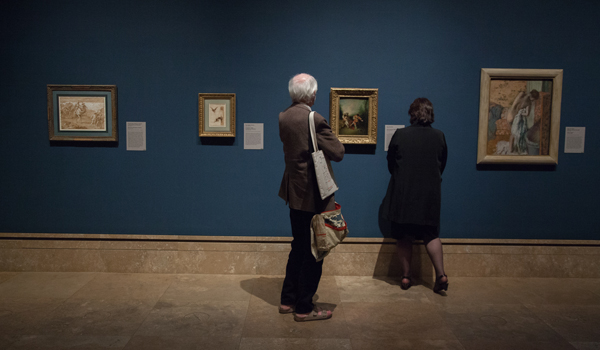CAA News Today
Register for Global Conversations: Materiality and Mediation
posted by CAA — August 08, 2022
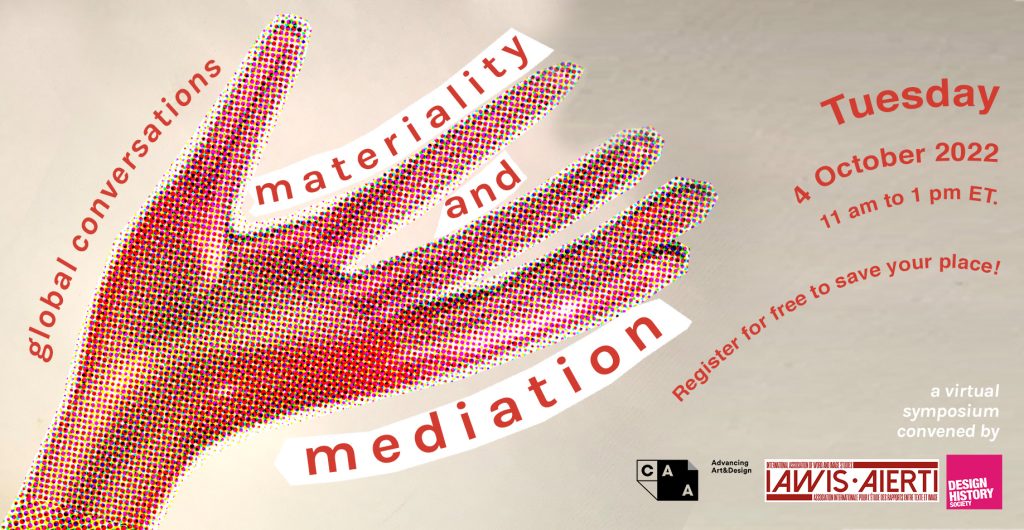
Join us this fall for the virtual symposium, Global Conversations: Materiality and Mediation, on October 4, 2022, organized by CAA and two of its international affiliated societies, the Design History Society and the International Association of Word and Image Studies.
To register for the event, visit this page. The event will take place from 11 am to 1 pm Eastern time.
This global collaborative project brings together three intersecting constituencies—art and design, design history, and word and image studies—to examine how materiality and mediation intersect.
Six participating scholars will present on the following topics, followed by Q&A and discussion. The event will be recorded and shared online following the event.
- “Tavolino di gioie”: The Mediation of Material Techniques in Late Cinquecento Hardstone Inlaid Tables – Wenyi Qian, Ph.D. Candidate in Art History, University of Toronto, Toronto
- Mediating the Meaning of Textiles through Exhibition Displays in Israel, 1950s-1970s – Noga Bernstein, Marie-Sklodowska Curie Visiting Researcher, Hebrew University of Jerusalem
- Made in Japan: Development of the Poster Medium in Japanese Commercial Art and Design – Nozomi Naoi, Associate Professor of Humanities, Yale-NUS College, Singapore Erin Schoneveld, Associate Professor of East Asian Languages and Cultures and Director of Visual Studies, Haverford College, Haverford, Pennsylvania
- Mine Craft: Design Histories of Mining – Ellen Huang, Associate Professor of Art and Design History, ArtCenter College of Design, Pasadena, California Arden Stern, Assistant Professor of Humanities and Sciences, ArtCenter College of Design, Pasadena, CA
This no-cost event is open to the public. Please consider donating to support no-cost programming and providing access to new and emerging scholarship.
CAA’s membership program connects you to the largest community of individuals and organizations working together and advocating to advance research, practice, and the impact of the visual arts. Visit our website for more information and to join our organization.
Arts organizations interested in joining CAA as an affiliated society can do so by visiting our website.
To join the Design History Society, please visit this page.
To join the International Association of Word and Image Studies, please visit this page.

CAA at 2021 Advocacy Days
posted by CAA — April 16, 2021
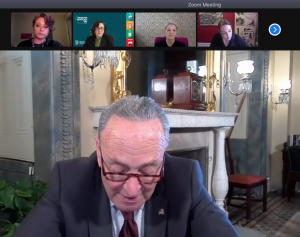
Screenshot of CAA in virtual conversation with NY Senator Chuck Schumer, 2021
CAA representatives advocated for the arts and humanities with partners at the American Association of Museums (AAM) and the National Humanities Alliance (NHA) this spring for Museums Advocacy Day on February 23 and Humanities Advocacy Day on March 11, 2021. Alongside other academic societies, scholars, and museum professionals, CAA urged congressional representatives and senators to back full funding for the National Endowment for the Arts (NEA), the National Endowment for the Humanities (NEH) and particularly the Institute for Museum and Library Services (IMLS), which provides grants for museums and arts organizations throughout the country, for the fiscal year 2022. Increased allocations for these programs would bring funding levels back to what they were over a decade ago in 1998. We met with the offices of New York representatives Tom Reed, Jerry Nadler, Carolyn Maloney, John Katko, and Yvette Clarke and senators Kirsten Gillibrand and Chuck Schumer. Sen. Schumer joined Museums Advocacy Day in person to share his enthusiasm about moving forward with emergency relief funds for arts organizations and supporting more space for them in the next year’s congressional budget.
CAA has been participating in these meetings for the past three years. We noted that 1/3 of all museums in the US are at risk of closing without assistance. We also stressed the importance of museums as institutions that have served our community greatly during COVID and have come up with creative solutions for childhood education, community building, virtual exhibitions, and out-of-the-box engagement strategies. The arts and humanities have helped our communities cope and their spaces—schools, libraries, and museums—remain some of the only spaces in communities that can be accessed freely by the public.
RAAMP Coffee Gathering: Differentiating Visual Arts Admin and Museum Studies Programs
posted by CAA — January 16, 2020
Coffee Gathering: Differentiating Visual Arts Administration and Museum Studies Programs
On Thursday, February 6 at 2pm (EST) we will be online with Bruce J. Altshuler, Director and Professor of Museum Studies at New York University and Sandra Lang, Director and Professor of Visual Arts Administration at New York University to discuss their respective programs. Joining them will be Visual Arts Administration student Laura Busby and Museum Studies student Olivia Knauss.
For participant bios, see the full post on RAAMP.
To join this Coffee Gathering, please email Cali Buckley at cbuckley@collegeart.org.
RAAMP Coffee Gatherings are monthly virtual chats aimed at giving participants an opportunity to informally discuss a topic that relates to their work as academic art museum professionals. Learn more here.
Submit to RAAMP
RAAMP (Resources for Academic Art Museum Professionals) aims to strengthen the educational mission of academic art museums by providing a publicly accessible repository of resources, online forums, and relevant news and information. Visit RAAMP to discover the newest resources and contribute.
RAAMP is a project of CAA with support from the Andrew W. Mellon Foundation and the Samuel H. Kress Foundation.
RAAMP Coffee Gathering: My Gallery Is Bigger Than Your Gallery
posted by CAA — November 13, 2019
Coffee Gathering: My Gallery Is Bigger Than Your Gallery
 On Thursday, November 21, 2019 at 2 PM (EST) RAAMP will be online with Michael Dickins, the curator and director of The New Gallery at Austin Peay State University. He will talk about the campus plan he created which enables him to share the gallery’s collection in the university’s community spaces.
On Thursday, November 21, 2019 at 2 PM (EST) RAAMP will be online with Michael Dickins, the curator and director of The New Gallery at Austin Peay State University. He will talk about the campus plan he created which enables him to share the gallery’s collection in the university’s community spaces.
“My formal gallery is 1500 sq. Ft,” writes Dickins. “My actual gallery is 186 acres of surrounding campus. I list my Gallery as my primary residence, but the rest of my campus is my second home, or better yet, a cultured land that includes some of my favorite vacationing spots.”
“I often use academic buildings, student common areas and the campus landscape to install works of art to not just boost the presence of the Department of Art+Design around campus, but as extensions of the gallery to educate students and the campus community about art and to generate conversations. These installations of artworks have bred collaboration between departments, administration and, more importantly, the facilities and grounds crews. They have also been excellent teaching opportunities for my students to learn about curating, installation, collaboration and managing red tape.”
To RSVP to this online coffee gathering, please email Olivia Knauss at oknauss@collegeart.org
RAAMP Coffee Gatherings are monthly virtual chats aimed at giving participants an opportunity to informally discuss a topic that relates to their work as academic art museum professionals. Learn more here.
Submit to RAAMP
RAAMP (Resources for Academic Art Museum Professionals) aims to strengthen the educational mission of academic art museums by providing a publicly accessible repository of resources, online forums, and relevant news and information. Visit RAAMP to discover the newest resources and contribute.
RAAMP is a project of CAA with support from The Andrew W. Mellon Foundation.
RAAMP Coffee Gathering: Designing a Collection Plan
posted by CAA — October 16, 2019
RAAMP (Resources for Academic Art Museum Professionals) Coffee Gatherings are monthly virtual chats aimed at giving participants an opportunity to informally discuss a topic that relates to their work as academic art museum professionals.
Coffee Gathering: Designing a Collection Plan
On Tuesday, October 22 at 3 PM (EST), RAAMP’s online Coffee Gathering will focus on the process of creating collection plans in academic art museums. Through a series of questions, we will explore who should be involved in creating a collection plan, what information it should provide, and who it should serve. In discussing these topics, we hope to have related conversations about the challenges and opportunities creating a collection plan can provide staff and institutions.
This topic has emerged from the curious lack of publicly available collection plan examples. We hope to provide colleagues in academic art museums the opportunity to connect and share their experiences with writing collection plans.
Questions we will discuss include:
- What sections should be included?
- How does the collection plan integrate others, such as the university’s strategic plan, interpretive plan, and/or collections management policy?
- Who should be involved in creating the document?
- How might an academic art museum include their various communities in the process?
- With colleagues in your museums, how do you successfully have conversations on how to limit or focus a collection, especially at an encyclopedic museum?
- How might this document be helpful for donors?
- Do you share your collection plan publicly?
- How often do you revisit and revise your collection plan?
To RSVP to this online coffee gathering, please email Olivia Knauss at oknauss@collegeart.org
Submit to RAAMP
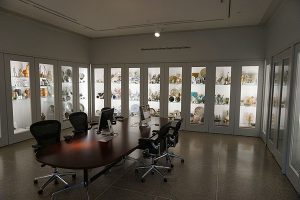
The Albertine Monroe-Brow study-storage gallery at the University of Michigan Museum of Art.
RAAMP (Resources for Academic Art Museum Professionals) aims to strengthen the educational mission of academic art museums by providing a publicly accessible repository of resources, online forums, and relevant news and information. Visit RAAMP to discover the newest resources and contribute.
RAAMP is a project of CAA with support from The Andrew W. Mellon Foundation.
RAAMP Coffee Gathering: Curatorial Work as Academic Labor
posted by CAA — September 17, 2019
RAAMP (Resources for Academic Art Museum Professionals) Coffee Gatherings are monthly virtual chats aimed at giving participants an opportunity to informally discuss a topic that relates to their work as academic art museum professionals.
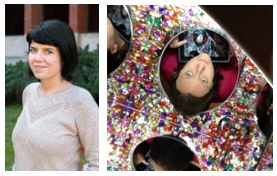
Coffee Gathering: Curatorial Work as Academic Labor
On Tuesday, September 24 at 3:00 PM (EST) RAAMP will be speaking with Meredith Lynn and Claire L. Kovacs.
To RSVP to this coffee gathering, please email Cali Buckley at cbuckley@collegeart.org
Meredith Lynn is an artist, curator, and educator based in Tallahassee, Florida. In her art practice she frequently explores the historical, political, and social issues surrounding land management and ownership. Her curatorial specialty is contemporary art, with a particular focus in interactive and new media art. Her work has been supported by the National Endowment for the Arts, the Indiana Arts Commission, the Minnesota State Arts Board, Northern Lights, and the Florida Department of Cultural Affairs and most recently shown at the Morris Graves Museum of Art in Arcata, California and the Wiregrass Museum in Dothan, Alabama. She is curator of the Museum of Fine Arts at Florida State University where she also teaches in the Department of Art.
Claire L. Kovacs is the Curator of Collections and Exhibitions at Binghamton University. She obtained her PhD from the University of Iowa and her master’s and bachelor’s degrees from Case Western Reserve University – all in art history. She has curated exhibitions at the Figge Art Museum, Coe College, Krasl Art Center, DePaul University, and at Augustana College, where she was (until recently) the Director of the Augustana Teaching Museum of Art. Her strategies for curatorial work and programming emphasize the ways that academic museums explore contemporary issues, foster interdisciplinary inquiry, create space for a multiplicity of voices and perspectives, and function as a site of dynamic community engagement. She underscores intersectional equity, diversity, accessibility and inclusion in her curatorial work. Her research practice grapples with ways that art historical research can support ‘The Common Good’ (to borrow a phrase from the NEH), using curatorial practice and writing as a mechanism by which to amplify under-told stories.
Submit to RAAMP
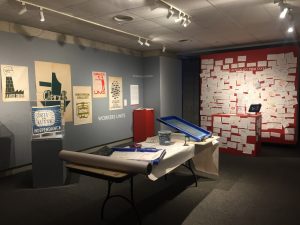
RAAMP (Resources for Academic Art Museum Professionals) aims to strengthen the educational mission of academic art museums by providing a publicly accessible repository of resources, online forums, and relevant news and information. Visit RAAMP to discover the newest resources and contribute.
RAAMP is a project of CAA with support from The Andrew W. Mellon Foundation.
For Third Year in a Row, Trump Administration Threatens to Cut NEA and NEH Funding
posted by CAA — March 19, 2019
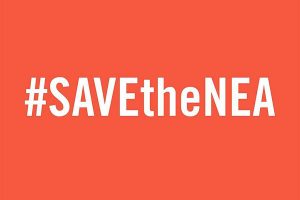
For the third consecutive year, the Trump administration is aiming to eliminate the National Endowment for the Arts and the National Endowment for the Humanities.
Trump unveiled a $4.75 trillion budget—the largest in federal history—on March 11, but details about his plans for the NEA and NEH were announced yesterday in the administration’s full proposal. According to the documents, the NEA’s budget is marked at $29 million and the NEH’s is at $38 million—which the proposal describes as “sufficient funding for orderly termination of all operations over two years.”
Since 2017, Trump has been vocal in his desire to eliminate the two agencies entirely. In 2019, each of the agencies was allocated a budget of $155 million, despite similar calls for elimination in 2018 and 2019. The US federal budget for 2020 will ultimately be decided by Congress.
We’ll be fighting back again this year and hope that you do, too. The most effective way to make your voice heard is through your local representatives. Call. Email. Write letters.
Urge your representatives to sign on to this NEA funding letter and this NEH funding letter, which ask for budgets of $167.5 million for each agency.
Signing deadline: March 27, 2019
Click here to access the CAA Arts and Humanities Advocacy Toolkit.
CAA Announces Guidelines for Addressing Proposed Cuts to Arts and Humanities Programs and Departments
posted by CAA — November 12, 2018
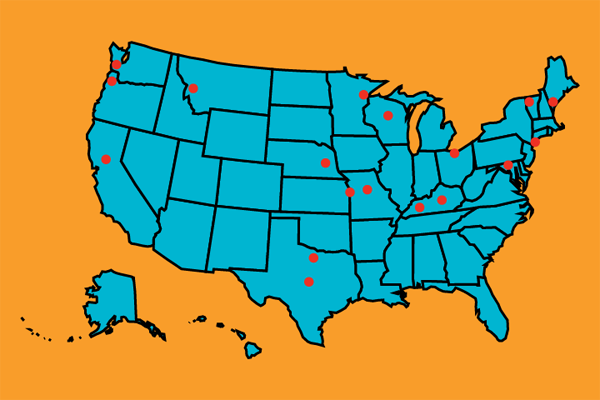
Campuses across the country have been affected by cuts to the arts and humanities. See the full list here. Graphic: Allison Walters
By any number of metrics, the arts and humanities are experiencing challenging times. Funding is under threat from the Federal government. Student enrollment is dropping in higher education classes focusing on the arts and humanities. The number of tenure-track faculty positions are diminishing in arts and humanities departments. The wide support of STEM-centered education has placed an emphasis on career paths with measurable and immediate financial outcomes. Yet, we know the importance of an arts and humanities education, not just for those looking to have careers in the arts and humanities but those across the entire professional spectrum.
In response to the challenges in the arts and humanities, some universities and colleges in the United States have cut programs, collapsed libraries, or shuttered entire departments. These steps, taken as cost-saving measures, only increase the uphill battle for the arts and humanities. Over the past years, CAA has tracked these changes in higher education through the organization’s own research efforts and through narratives relayed directly from our members. These actions taken by administrations are in no way secret. In article after article, the alarm has been sounded. We believe there is a better way to resolve these issues and protect the arts and humanities at the same time.
To bridge this divide, CAA is pleased to release “Guidelines for Addressing Proposed Substantive Changes to an Art, Art History or Design Unit, or Program at Colleges and Universities.”
“These guidelines provide a path for open communication between faculty and administration,” says Hunter O’Hanian, executive director of CAA. “With this new tool to be used by both administrations and faculty equally, CAA builds a resource that is vital to strengthening the arts and humanities on campuses. The guidelines create clearly definable steps and parameters for a process that when handled badly leads to fissures between faculty, students, and administrations.”
The “Guidelines for Addressing Proposed Substantive Changes to an Art, Art History or Design Unit or Program at Colleges and Universities” call for a deeper understanding of the factors and issues that have precipitated the action to close a department or program. The guidelines outline two clear paths: they encourage constituencies to communicate about the potential changes, and they pave the way to resolution without having to eliminate or downsize the program or department.
If those conversations fail to reach a satisfactory outcome with the educational institution, the guidelines emphasize that the institutional administration must do everything it can to see that the program continues. And, as is the case with all scholastic endeavors, the administrations must show their work—they must provide documentation that the department has been adequately resourced and funded. It must demonstrate that growth has been encouraged rather than to allowing it to lay fallow.
“CAA remains convinced that students and society derive lasting benefit when institutions offer a diverse range of academic resources to support different learning styles,” says Jim Hopfensperger, president of the CAA Board of Directors. “These new CAA guidelines outline best practices toward sustaining this essential diversity of academic programs and operational assets.”
Hopfensperger adds that “CAA believes that students, staff, faculty, and institutional leadership teams are all well served by inclusive processes, open lines of communication, engagement across constituencies, and empathetic deliberations.”
IMPACT OF ARTS AND HUMANITIES TOOLKIT
COLLEGES FACING CUTS TO ARTS AND HUMANITIES PROGRAMS
Authors and Contributors for the “Guidelines for Addressing Proposed Substantive Changes to an Art, Art History or Design Unit or Program at Colleges and Universities”:
CAA Working Group for Guidelines for Addressing Proposed Substantive Changes to an Art, Art History or Design Unit or Program at Colleges and Universities: Tom Berding, Michigan State University; Brian Bishop, Framingham State University (Chair, CAA Professional Practices Committee); James Hopfensperger, Western Michigan University (CAA Board President); Charles Kanwischer, Bowling Green State University; Karen Leader, Florida Atlantic University; Richard Lubben, College of the Sequoias; Paul Jaskot, Duke University; Hunter O’Hanian, CAA Executive Director.
CAA to Issue Guidelines for Addressing Changes to Visual Arts Programs at Colleges and Universities
posted by CAA — September 17, 2018
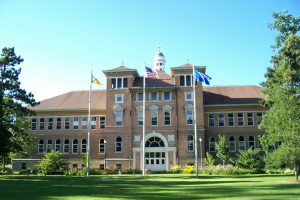
University of Wisconsin-Stevens Point (Royal Broil/Flickr)
Over the past few months there have been an alarming number of colleges and universities throughout the nation—from University of Wisconsin-Stevens Point to University of Texas at Austin—taking actions we perceive as detrimental to the education of future generations in the arts and humanities, particularly in the fields of art history, studio art, and design.
From our perspective, in many instances, it appears that decisions to merge departments, eliminate degrees, or reduce libraries are largely transactional in nature, designed to balance present-day budgets.
We worry that when focusing narrowly on fiscal realities of the day, institutions risk undervaluing the impact humanities programs have on preparing students for careers over their lifetimes. We believe that serving students of diverse racial, social, and economic backgrounds involves offering academic programs that allow them to fully explore themselves and their cultures, precisely the benefits from strong programs in the humanities, art history, studio art, and design.
We recognize that institutions must embrace structural changes, make adjustments in evolving physical and technological environments, and face pressures to demonstrate direct connections between academic studies and successful professions. Yet, we remain convinced, and research confirms, that students as individuals, and society as a whole, benefit from strong programs in the arts and humanities and a diverse range of academic resources to support different learning styles.
A CAA working group, co-chaired by Brian Bishop, Chair of the Professional Practices Committee and executive director Hunter O’Hanian, recently formed to propose Best Practices for Addressing Proposed Changes to an Art/Design Academic Unit, Library, or Degree at Colleges and Universities. It is hoped that these Best Practices will be approved by the CAA Board of Directors for dissemination by October 31, 2018.
We invite you to share with us specific situations that can help inform these guidelines. Please contact either Brian Bishop (bbishop@framingham.edu) or Hunter O’Hanian (Hohanian@collegeart.org) directly.
Call for Contributions to RAAMP (Resources For Academic Art Museum Professionals)
posted by CAA — August 15, 2018
RAAMP (Resources for Academic Art Museum Professionals) aims to strengthen the educational mission of academic art museums by providing a publicly accessible repository of resources, online forums, and relevant news and information.
With new resources added daily, we welcome contributions to our online archive. Resources can include but are not limited to: museum strategic plans; campaigns for outreach to campus communities; news and announcements about new programs, exhibitions, or staff appointments; and strategies for diversity and inclusion in the academic art museum. You may also provide tips on funding opportunities, exhibition design guidelines, advocacy, and more.
Visit RAAMP to discover our newest resources, and click here to contribute.
RAAMP is a project of CAA with support from The Andrew W. Mellon Foundation.




